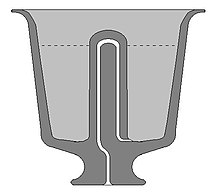Pythagorean cup


The Pythagorean cup (also known as the cup of justice ) is a drinking vessel that forces its user to pour only the usual amount. Thanks to its construction ascribed to Pythagoras of Samos , the cup allows its user to fill it to a certain height. If the user only fills the cup up to this height, he can enjoy his drink in peace. If he pours in more, the entire contents of the cup will run out at the bottom. With this cup, it is said, Pythagoras wanted to teach greedy people humility .
Form and function
A Pythagorean cup looks like a normal drinking vessel, except that the vessel has a central column. This sits directly above the shaft and over the hole at the foot of the shaft. A small open tube runs from this hole almost to the top of the central column, where there is an open chamber. This chamber is connected to a second tube that leads to the bottom of the center column, where an opening in the column lets in the contents of the beaker.
When the cup is filled, the liquid rises through the second tube up to the chamber in the top of the central column, according to Pascal's principle of communicating tubes . As long as the liquid does not rise above the level of this chamber, the cup will function normally. As soon as more is poured in, the entire contents of the cup pours out through the first tube and runs out at the bottom according to the siphon principle .
history
According to legend, Pythagoras' invention was used in the construction work on the water supply for the island of Samos , which he had planned and supervised. He worried about the large amount of wine consumed by the workers. On the island of Samos, the cup is known as Díkea Koúpa (Δίκαια Κούπα του Πυθαγόρα) and is also sold as a souvenir .
Heron of Alexandria (60 BC) describes the cup as a tantalus cup in his treatise Pneumatika , based on the figure of Greek mythology . Tantalos was punished by the gods and suffered eternal thirst in the midst of water (and eternal hunger) within reach.
These days, versions of the mug are sold in toy stores as a joke item .
See also
Web links
Individual evidence
- ↑ Physics demonstrations: the Pythagoras cup. Retrieved November 29, 2014 .
- ↑ Thomas Ewbank: A Descriptive and Historical Account of Hydraulic and Other Machines for Raising Water, Ancient and Modern: With Observations on Various Subjects Connected with the Mechanic Arts, Including the Progressive Development of the Steam Engine. In Five Books . tape 14 . Derby & Jackson, 1857, p. 520 ( limited preview in Google Book Search).

